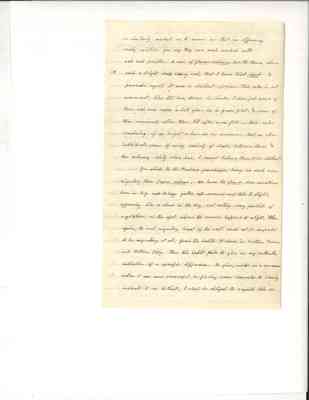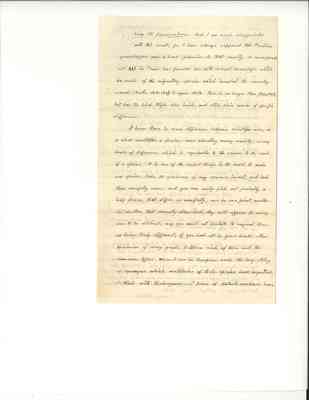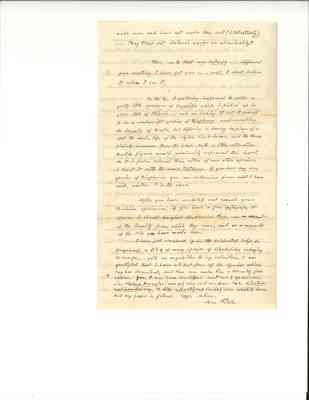Pages
page_0001
156
East Greenwich P.O. Dec. 12. 1857.
R.W. Kennicott, M.D.?
Dear Sir: - Tidings from you and from the far off country where you have been are truly refreshing. Your father was so kind as to write me last summer, informing me of your tour. And I am especially rejoiced to receive authentic specimens of the grasshopper, of the ravages of which, at Lord Selkirk's settlement, there have been newspaper accounts several times within the period of my remembrance. It was my first business to relax the most perfect one of the specimens, so as to expose its wings, and I have just been examining it - though night came on before I had looked carefully at every part. My strong conviction is, that it is not distinct from the femur. rubrum - of which there are many varieties, which differ so much that some enthusiast hereafter will try to make five or six different species out of it - as has been done with the very similar Acrydium Italicum of Europe. I have selected one point after another in these Pembina specimens, which I thought was different from the same part, in femur. rubrum; but on looking over one after another of my specimens of the latter, I have soon come to one,
page_0002
so similarly marked as to assure me that no difference really existed. You say they are much marked with red and purple. A var. of femur. rubrum has the thorax above such a bright deep cherry red, that I have tried hard to persuade myself it was a distinct species.. This color is not evanescent, like the love dress in birds. I once put some of these red ones under a bell glass, in a grass plat, & some of them remained alive there till after snow fell - their color remaining of as bright a hue as in summer. But, as other individuals occur of every variety of shade between these & the ordinary dirty olive hue, I cannot believe them to be distinct.
You allude to the Pembina grasshopper being so much more migratory than femur. rubrum. We know the fem. r. does sometimes here in N.Y. and N. Eng. gather into swarms and take to flight, appearing like a cloud in the sky, and eating every particle of vegetation on the spot where the swarm happens to alight. Then again, the real migratory locust of the east would not be suspected to be migratory at all, from the habits it shows in Southern France and Northern Italy. Thus this habit fails to give us any authentic indication of a specific difference. In fine, unless on a re-examination I am more successful in finding some character to clearly indicate it as distinct, I shall be obliged to regard this as
page_0003
being the femur. rubrum. And I am much disappointed with this result, for I have always supposed this Pembina grasshopper was a kind peculiar to that locality. A correspondent has in Texas has favored me with colored drawings which he made of the migratory species which invaded the country around Austin A. D. 1849 & again 1854. This is no longer than fem. rub. but has the hind thighs blue inside, and other plain marks of specific difference.
I know there is much difference between scientific men, as to what constitutes a species, some elevating every variety, every shade of difference which is cognizable to the senses, to the rank of a species. It is one of the easiest things in the world to make new species. Take 50 specimens of any common insect, and look them carefully over, and you can easily pick out probably a half dozen, that differ so manifestly, one in one point, another in another, that correctly described, they will appear to every one to be distinct; nay you would not hesitate to regard them as being truly different, if you had not in your hands other specimens of every grade between each of them and the common type. When I see in European works the long string of synonyms which multitudes of their species have acquired, I think with Shakespeare - "Some of Nature's workmen have
page_0004
made men and have not made them well (intellectually) - They trace out Nature's works so abominably."
Then, as to that new butterfly - different from anything I have yet seen - well, I shall believe it when I see it.
By the by, I yesterday happened to notice a pretty little specimen of Carabide which I picked up in your state of Illinois - and on looking it out it proved to be a nondescript species of Diaphorus, much resembling the dorsalis of Brulle, but differing in having in place of a spot, the whole tips of the elytra black-brown, and the thorax plainly narrower than the head. With a little alteration Brulle's figure would admirably represent this insect. As it is paler colored than either of our other species, I ticket it with the name testaceus. If you have any new species of Diaphorus, you can determine from what I have said, whether it is the same.
After you have assorted and named your Pembina specimens, if you have a few specimens to spare, I should be glad to receive them - on account of the locality from which they come, and as a momento of the trip you have made there.
I have just received from the celebrated Selys de Longchamp a ♂ & ♀ of every species of Libellulidae belonging to Europe - quite an acquisition to my collection. I am gratified that I have all but four of the species which Say has described, and thus can make him a tolerably fair return. You, I see, have heretofore sent me 3 specimens, viz. Aeshna Hercules (new sp.) also sent me from Ark. Libellulae rubicunda Say, & Lib. albostigma (n. sp.) also inhabits here. But my paper is filled. Ergo, Adieu.
Asa Fitch.



